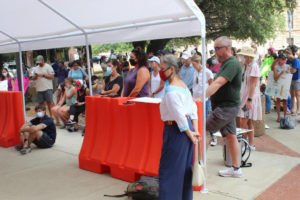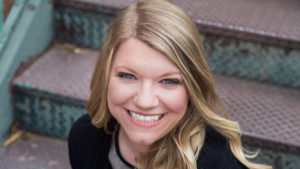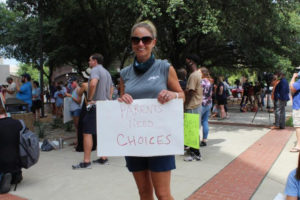At a recent outdoor rally calling for the reopening of Tarrant County classrooms, a mother with children in a private Christian school put it bluntly.
The virus, the mother said, “was not the plague” that we were told it would be.
“If you are elderly, it is going to be dangerous for you,” she continued. “We should never have quarantined the healthy. Viruses are a part of life.”
Her views were shared by several other parents I spoke with that morning outside the Tarrant County Administration Building downtown. The gist of their position is that the cost of delaying in-person learning for children and teenagers outweighs the public health risk. Echoing the concerns of local child advocacy nonprofits, many of the parents noted that teachers are often the first individuals to report signs of child abuse and neglect.

Photo by Edward Brown.
COVID-19 may not be a plague of Biblical proportions, but the highly infectious disease has led to more than 155,000 deaths in the United States, including 381 in Tarrant County. At the time of the rally, Tarrant County health officials, citing high numbers of COVID-19 cases in North Texas, ordered a countywide delay in classroom openings until September 28. Last week, State Attorney General Ken Paxton rescinded county health officials’ ability to close schools due to public health concerns. That order added volatility to an already emotionally charged situation.
School boards now have the authority to decide when their campuses open. After holding an emergency meeting last Thursday, Fort Worth school board trustees voted 8 to 1 to delay school openings until Tuesday, September 8. Classes will be online-only for the first four weeks. The majority of parents and teachers who spoke at the emergency meeting were in favor of delaying classroom openings. One school board trustee told me on condition of anonymity that the majority of parents pushing for classroom reopenings are from Tanglewood, a wealthy neighborhood near TCU that has been a hotbed of support for reopening classrooms.
Several Fort Worth school district teachers I spoke with are frustrated with the lack of direct information sent to them by district leaders. The educators, many of whom have spent decades in local classrooms, said they have had to rely on social media posts from Fort Worth school district for such vital information.
“I will be quitting if I am asked to physically go on campus,” said one Fort Worth public school teacher who asked to go only by “Taylor.” We are concealing the educator’s identity and those of two colleagues to prevent district backlash.
Texas teachers are fighting back. The Rally for Safe School Opening was held July 18 in downtown Austin to draw attention to a list of teacher demands. Hundreds of teachers and their supporters want virtual instruction until all county infection rates fall below .5% of the population, hazard pay for campus staff, paid leave for COVID-related illnesses in addition to regular leave benefits, and the option for staffers to work remotely if they have an autoimmune condition, among other demands.
Many teachers scoff at the guidelines by the Texas Education Association (TEA), the governing body of Texas public and charter schools. Requiring students of all ages to wear face masks is unrealistic, the teachers said. Requirements that students regularly wash their hands will be hard to fulfill, the teachers said, given the limited number of sinks in many schools. The idea that first and second grade students will stay 6 feet apart is unrealistic, multiple teachers said.
Some school districts across the country are putting teachers first. In California, the two largest school districts — Los Angeles Unified and San Diego Unified — are opting to start the fall semester online only, citing skyrocketing infection rates and despite presidential tweets saying that “SCHOOLS MUST OPEN.” Many large urban school districts have similarly voted to resume classes online only until classrooms can be safely reopened.
Local school districts and college campuses are offering a wide range of learning options. Crowley school district plans to begin online classes on Tuesday, September 8, according to a district spokesperson. School buildings are scheduled to open Monday, October 5. At that point, students will have the option of transitioning to in-person learning or remaining online through the school district’s Virtual Learning Academy.
“As we work with officials to monitor the spread of COVID-19 in our community, we must rely on science, data, and common sense as we make these difficult decisions that impact all families,” a district statement read. “Additional delays may be required based on the spread of the COVID-19 pandemic.”
Eagle Mountain-Saginaw school district classrooms will reopen on Thursday, August 20, according to the district’s website. Students will have the option of resuming in-person classes or using the district’s Choice Remote Learning program.
“Of everyone I’ve talked to, none of [my colleagues] feel comfortable with being put on campus,” Taylor said. “Some would be OK with teaching virtually from campus. I can’t see a solution right now, and I don’t see it getting better. There are so many opportunities for taking COVID home once school resumes. I feel like the case numbers might explode.”
*****
When word reached Taylor last March that Fort Worth school district’s campuses would be shuttering, the art teacher began transitioning to online learning. Taylor was pleasantly surprised to discover that online lessons, while not always ideal, provided students with the tools and resources to continue developing in areas like drawing, painting, and other artistic media. The ability to work from home brought emotional relief for Taylor, who has an autoimmune condition.
“I went into full lockdown,” Taylor recalled. “I have not seen friends and family since March.”

Courtesy of Ashley Paz.
As the COVID-19 pandemic and the resulting wave of deaths spread, the art teacher continued to take precautions — such as using contactless food deliveries and avoiding groups of people — that have stemmed the spread of the novel coronavirus in countries like Japan, Korea, and the Czech Republic, among others. The United States has not taken a uniform approach to stopping the spread of the illness and now leads the world in total COVID-related deaths, and Texas is now a leading hotspot for new COVID-19 cases. There are an estimated 141,186 active COVID-19 cases in the Lone Star State, according to the Department of State Health Services.
As Taylor watched COVID-19 cases rise, she was shocked to see Fort Worth school district Facebook posts that suggested classroom reopening plans. One June 17 post hinted that schools would reopen that fall even as the school district failed to update teachers directly, according to several Fort Worth teachers I have spoken with.
Citing a recent parent poll, the post said, “Of that number, as we have previously shared, 52% said they preferred the traditional school calendar this fall.”
Several comments asked if the post indicated a direction that the school district would be going in that fall.
“So, just for clarification,” one woman responded, “by sharing the survey results, are you saying that this will be what we can officially expect for next year (traditional calendar, alternating day schedule)? Or do we still need to wait for [TEA] to give us the official word?”
At the time, the TEA had not provided safety guidelines and reopening protocols for Texas schools. When those guidelines were released on July 7, that further suggested that public school teachers would be asked to return to school campuses.
One Fort Worth school district teacher who asked to go by Pat said her pre-existing conditions have made early retirement a foregone conclusion, given the district’s stance on mandatory on-campus teaching. Pat’s spouse has diabetes, and the thought of their children losing one or both parents has created a “web of horror,” Pat said.
The long-time public school teacher said “99.9%” of her colleagues have expressed an intention to not return to campus this year.
“Most of us don’t feel safe because we know that it is a volatile situation,” Pat said. “How are they going to learn in groups? We normally learn in groups. This is going to be a rigid environment that, in a way, will be more traumatizing” for children than the pandemic.
Poor air ventilation — another common concern among teachers I spoke with — weighs on Pat.
“My air-conditioner works maybe two days a week,” Pat said. “You can’t open the windows because bugs fly in, and it’s hot. I don’t have my own AC unit. I share an air-conditioner with three other classrooms, and we’re all dying from poor ventilation during hot months. How will that be safe?”
Pat said the school district should build on the lessons learned last spring when students transitioned to online learning instead of rushing to open classrooms.
The third Fort Worth school district teacher I spoke with, Sam, said COVID-19-related fears have risen since March as teachers have learned more about the disease.
“I think [school administrators] were feeling pressure” to reopen, Sam said. “Instead of making a careful decision, they just gave in to the pressure” from parents who, for a variety of personal or ideological reasons, are calling for classrooms to reopen soon.
Sam, a single parent, has one son in the school district. Being forced to return to classrooms effectively means that Sam’s son cannot participate in remote learning since Sam will not be home.
“I am scared,” the teacher said. “I’m really angry because the decisions that are being made are not good for me. It will be more work and a threat to my health. After teaching online in the spring, I can tell you virtual teaching takes just as much time as in-person teaching. Trust me, teachers would prefer to be face-to-face if we felt safe, but that is just not the case right now. The thought of teaching in-person while COVID numbers are still so high is terrifying.”
*****
Ashley Weaver knew early on that her three children would not be returning to the classroom when Eagle Mountain-Saginaw school district resumed in-person learning this fall.
“My biggest fear is them bringing [COVID-19] into the house,” the pregnant mother said. “We will have a newborn. My mom has some autoimmune disorders. We are living with her currently. Kids in general are germ carriers. That is just known. Even if it did not infect the kids like adults, just the fear of bringing that to a baby with no immune system and my mom who is compromised is scary.”

Photo by Edward Brown.
Her school district offers a “Save Your Seat” policy that allows parents to opt for virtual learning for six weeks. At that point, children can resume in-person learning if the parents choose to. Her school district, she said, has handled the volatile situation as best as it can.
“I can relate to having to change policies daily,” the mother said. “They are at the mercy of the government. Everything they are sending to parents, people are demanding answers. I know they just don’t know. I feel bad that they keep getting backlash.”
Based on Facebook messages she has had and private conversations, Weaver has heard concerns from financially strapped parents and single parents who are unsure how they can provide for their children while watching them at home through late September.
“I hate that stigma where parents treat schools like a babysitter, but society forces that to happen because you have to have parents working,” Weaver said. “My heart went out to people who will have serious challenges finding a babysitter or teaching their kids. I know some parents who are going to withdrawal from school” so they don’t have to deal with the stress of keeping up with school curriculum.
The weeks and months of homeschooling that followed the closing of school campuses last spring were difficult, Weaver said.
“I used to be an education major,” she said “and now I know I can’t handle being a teacher. There will be a ton of hardships. All four of us were getting frustrated with it. We would take a break for the rest of the day out of frustration sometimes.”
Ashley’s husband, Dayne Weaver, runs Dayne’s Craft Barbecue from the grounds of Lola’s Trailer Park and works long hours. He helped when he could during the scarce few hours he had after returning from work last spring. Ashley turned to homeschool Facebook groups for advice that she plans to use once again this fall.
A lot of Ashley’s groups recommended shorter learning periods for younger children. “Before, we would sit at the table for four to five hours. I learned to give them as much sleep as they want and to let them stay in their pajamas. Children will not retain information if they dread learning. The advice made it more fun and easier for the whole household.”
Even if her school district were to open its classrooms sooner under Paxton’s new directives, Weaver is in no hurry to send her kids back to classrooms. She is waiting to see a drop in cases and to hear feedback from parents who can give her first-hand information about what learning during a pandemic is like.
“I don’t want to send my kids to a prison where they have to sit 6 feet away from everyone, not talk to anyone, and wear a mask all day,” she said. “I don’t want school to feel like a punishment. I want them to enjoy learning. If I am sending them to a sterile environment where they are not allowed to interact, that is what they will remember instead of the education they would be receiving. I am prepared to teach the entire year. I know that I will get overwhelmed, but my personal comfort is less of a priority than my kids’ physical health.”
Brenda Ciardiello, a Fort Worth mother of three, said she has talked over school reopening plans with her husband Matt Ciardiello. Her children will return to classrooms when they reopen.
“We don’t have high-risk people in our family,” she said, referring to conditions and risk factors (like advanced age and obesity) that can lead to COVID-19-related complications or even death. Brenda’s two parents live hours away, so there are no senior relatives who would readily come into contact with her children, she said.
“Matt and I are pretty healthy,” she continued. “Just from polls from our PTO and PTA, at least from the people who are responding, the vast majority are transitioning to in-person.”
The decision to resume in-class lessons wasn’t easy, but the Ciardiello family weighed the costs and benefits of learning from home for another year.
“I don’t think it is good to do virtual all year, having gone through the virtual learning in the spring,” she said. “My youngest kids were doing maybe one or two Zoom meetings a week, and they were having trouble staying engaged for that period of time. [Fort Worth school district] has promised a more engaging online program, but, at those ages, it is so hard to make them want to engage with a screen.”
Although sometimes slow access to information from the school district has been frustrating, Brenda said most of the parents she has spoken to understand the difficult situation the school district is in. One area that remains unclear, Brenda said, is how remote learning students will meet attendance requirements that are set by the state and tied to school district funding.
“How can you expect parents who are working to have flexibility?” she asked. “They may not be able to attend every Zoom meeting. There is a real worry that kids will be penalized when, in reality, for most parents, it is almost impossible to do things the way” the district is asking them.
Brenda is making last-minute decisions about what types of face masks her kids will wear. Parents have been advised to purchase Velcro so they do not have to be tied by teachers. The social interactions that come with in-person learning are too valuable to miss out on, Brenda said. When she finally does drop her kiddos off for class, she said the feeling will be bittersweet.
“There will be some relief,” she said. “My kids need that interaction. They need that routine. Children are less likely to get sick, but they still do get sick. Not to mention there is this perfect storm. It will be flu season by October. All the other sicknesses of the world haven’t disappeared just because COVID is here. As much as I want my kids to get back to school, there are concerns we have to walk through. We have to be flexible. I’m kind of writing off 2020. I don’t want to make any big commitments.”
*****
One reopening video by a local private school may leave viewers thinking that opening classes during a pandemic is something to be excited about. Bright, upbeat music accompanies shots of construction partitioning gyms into expanded classes with desks spaced 6 feet apart. Fort Worth’s private schools are largely opening mid-August.
The resources available to private schools that charge around $25,000 in tuition per year have made reopening both possible and something of a financial imperative. Public schools have a more stable income source through tax revenue, but that hasn’t stopped parents in wealthy Fort Worth neighborhoods from blasting school district trustees for delaying in-person learning due to legitimate public safety concerns.
“Shame on you FWISD school board,” one mother posted on the Facebook group Back in School. “The decision you made today will have lifelong impacts on the students you represent. Students will be sex-trafficked, pregnant, commit suicide, starve, be beaten, and illiterate because of you.”
The exact link between a delay in school openings and teen pregnancy wasn’t made clear in the Facebook post.
Fort Worth school board trustee Ashley Paz said the district could have feasibly opened on August 17 but chose to delay school openings for several reasons.
“In the end, we all felt that the additional weeks will give campus administrators more time to prepare and plan as well as to make contacts with each family they serve and guarantee they have access to technology,” she said. “Campus administrators and district officials can provide information sessions online or in person for parents who need assistance with navigating the technology they are receiving. Additionally, this gives our student support services team time to work with partner agencies like [Texas Department of Mental Health and Mental Retardation], Tarrant Housing Solutions, One Safe Place, and United Way to address social needs that have been a major concern for all of us during this pandemic. The district has taken the onus of addressing these needs on top of our educational program for decades, but at this time we need the support of our community partners to help fill this gap so our administration can focus exclusively on teaching and learning.”
The economic necessities of providing nourishment (both in body and mind) for tens of thousands of Fort Worth’s youths are not lost on the teachers I spoke with. They understand that opening classes would provide significant relief for working parents. As has too-often been the case with public education, though, the guidelines set out by TEA and last-minute orders by government officials are yet another unfunded mandate that teachers have to burden. The difference this time is that this challenge, COVID-19, could kill them.
Pat said the message from Fort Worth school district’s leadership is clear.
“I’ve watched the district change,” Pat said. “They’ve gone from seeing us as human resources to human capital. I feel that is all we are to them — capital.”












